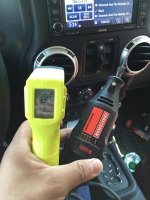You are using an out of date browser. It may not display this or other websites correctly.
You should upgrade or use an alternative browser.
You should upgrade or use an alternative browser.
10Th Anniversary Power Dome Hood
- Thread starter Ddays
- Start date
2nd.gunman
Caught the Bug
He is trying to say the ram air make it work like a hair dryer, failing to realize that the stream from the hair drier isn't straight but curve up because heat rises. it may not be a large curve but its there, At low speeds I would imagine these vents are very effective. We us cowl flaps on aircraft that are of similar design and they work extremely well. AT high speed with no liners would more hot air be forced out through those larger holes? Yes. What if you leave the liners in? Do to Bernoulli's principle the smaller opening may result in greater velocities and increase the heat sink abilities.
Totally agree, and much better than i could have said it but he asked me which way heat flows and i was pointing out it depends on what is acting on it. Of course it will eventually rise but it doesn't always go straight up.
Coop
Caught the Bug
Lol!!^^^^^^^
Last edited:
2nd.gunman
Caught the Bug
So i was quite busy today so i didn't post this till now but this morning i thought i'd do a little flow visualization using string on the way to work. As i suspected the raised lip in front of the vents causes the flow to separate and form an eddy to form at the opening of the first vent allowing the flow to reverse leading to localised high pressure right at the opening of the vent. The second vent gets some laminar flow over it at lower speeds (60 kph) which was a surprise but it suffered the same problem as the first as the speed increased (100 kph) again local high pressure due to an eddy forming at the opening of the vent. The third vent was heavily affected by airflow off the side of the dome in the centre of the hood but still the showed the same flow reversal and localised high pressure. This photo was taken after stopping in traffic from a high of 60/70 kph and you can see the string on the first vent has reversed and is slightly sucked into the third vent.
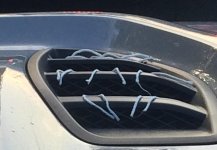
The second photo was taken at approx 100 kph and you can see that the string is reversed on the first vent and being sucked back into second and third vents.
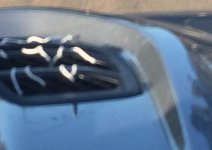
It would have been better if i had a video as they move around a fair bit but it was hard enough getting pictures. If someone who has cut their vents would like to do the same experiment i'd be interested to see the results as i think it would be fairly similar and you would see air being sucked into the vents rather than out of them.

The second photo was taken at approx 100 kph and you can see that the string is reversed on the first vent and being sucked back into second and third vents.

It would have been better if i had a video as they move around a fair bit but it was hard enough getting pictures. If someone who has cut their vents would like to do the same experiment i'd be interested to see the results as i think it would be fairly similar and you would see air being sucked into the vents rather than out of them.
Coop
Caught the Bug
Nice job! At crawl speed when the fan kicks on, wonder if there is low enough static pressure to force the air out?So i was quite busy today so i didn't post this till now but this morning i thought i'd do a little flow visualization using string on the way to work. As i suspected the raised lip in front of the vents causes the flow to separate and form an eddy to form at the opening of the first vent allowing the flow to reverse leading to localised high pressure right at the opening of the vent. The second vent gets some laminar flow over it at lower speeds (60 kph) which was a surprise but it suffered the same problem as the first as the speed increased (100 kph) again local high pressure due to an eddy forming at the opening of the vent. The third vent was heavily affected by airflow off the side of the dome in the centre of the hood but still the showed the same flow reversal and localised high pressure. This photo was taken after stopping in traffic from a high of 60/70 kph and you can see the string on the first vent has reversed and is slightly sucked into the third vent.
The second photo was taken at approx 100 kph and you can see that the string is reversed on the first vent and being sucked back into second and third
It would have been better if i had a video as they move around a fair bit but it was hard enough getting pictures. If someone who has cut their vents would like to do the same experiment i'd be interested to see the results as i think it would be fairly similar and you would see air being sucked into the vents rather than out of them.
jeeeep
Hooked
well, not sure strings are the best test matter due to their weight, length and being tied to the surface. once they reach extension in air flow they will tend to double back and pull back in, shorter the string the less travel the more it will reverse on itself, long string does the same thing just not as much.
this test would probably work out better with a fog machine so you the actual air flow can be observed and not be limited to its travel.
i'm thinking a fog machine and a couple of cheap box fans placed so they blow into front of the the radiator and across the hood, jeep at idle and temperature so the fan kicks on, maybe at 2000rpm.
hot air always rises so i am still inclined to think the vents will allow the hot air to escape.
this test would probably work out better with a fog machine so you the actual air flow can be observed and not be limited to its travel.
i'm thinking a fog machine and a couple of cheap box fans placed so they blow into front of the the radiator and across the hood, jeep at idle and temperature so the fan kicks on, maybe at 2000rpm.
hot air always rises so i am still inclined to think the vents will allow the hot air to escape.
Last edited:
Irish JK
Caught the Bug
So i was quite busy today so i didn't post this till now but this morning i thought i'd do a little flow visualization using string on the way to work. As i suspected the raised lip in front of the vents causes the flow to separate and form an eddy to form at the opening of the first vent allowing the flow to reverse leading to localised high pressure right at the opening of the vent. The second vent gets some laminar flow over it at lower speeds (60 kph) which was a surprise but it suffered the same problem as the first as the speed increased (100 kph) again local high pressure due to an eddy forming at the opening of the vent. The third vent was heavily affected by airflow off the side of the dome in the centre of the hood but still the showed the same flow reversal and localised high pressure. This photo was taken after stopping in traffic from a high of 60/70 kph and you can see the string on the first vent has reversed and is slightly sucked into the third vent.
View attachment 217672
The second photo was taken at approx 100 kph and you can see that the string is reversed on the first vent and being sucked back into second and third vents.
View attachment 217673
It would have been better if i had a video as they move around a fair bit but it was hard enough getting pictures. If someone who has cut their vents would like to do the same experiment i'd be interested to see the results as i think it would be fairly similar and you would see air being sucked into the vents rather than out of them.
Wow. Cool science project, but completely worthless to this discussion.
HighwayTrout
Hooked
2nd.gunman
Caught the Bug
well, not sure strings are the best test matter due to their weight, length and being tied to the surface. once they reach extension in air flow they will tend to double back and pull back in, shorter the string the less travel the more it will reverse on itself, long string does the same thing just not as much.
this test would probably work out better with a fog machine so you the actual air flow can be observed and not be limited to its travel.
i'm thinking a fog machine and a couple of cheap box fans placed so they blow into front of the the radiator and across the hood, jeep at idle and temperature so the fan kicks on, maybe at 2000rpm.
hot air always rises so i am still inclined to think the vents will allow the hot air to escape.
Correct not the best test but a proven method. I'd like to see a fog or smoke test if someone wants to do it but I'm not that interested.
While hot air always rises think about the flow path the air has to taken through the radiator into the spinning pulleys, 90 degree turn to go up then snake between the hood and the engine cover just to reach the underside of the vents. Not the easiest flow path. I think you would definitely get some leakage through the vents at low speed but it would be negligible.
2nd.gunman
Caught the Bug
Wow. Cool science project, but completely worthless to this discussion.
Obviously it did nothing to soothe your butthurt but that's not why I did it. Unless you've got something to prove to me that I'm wrong I'm finished with this thread.
Irish JK
Caught the Bug
Obviously it did nothing to soothe your butthurt but that's not why I did it. Unless you've got something to prove to me that I'm wrong I'm finished with this thread.
Nothing hurt here. Just want to make sure others with or that are looking into 10a hoods reading this thread, understand that you are talking theoretical about something you have not done.
2nd.gunman
Caught the Bug
Nothing hurt here. Just want to make sure others with or that are looking into 10a hoods reading this thread, understand that you are talking theoretical about something you have not done.
As opposed to you talking about something you've done without anything to back it up
Irish JK
Caught the Bug
Unless you've got something to prove to me that I'm wrong I'm finished with this thread.
I thought you were done with this thread?
As opposed to you talking about something you've done without anything to back it up
Yes.....key phrase.....something I have done.
HighwayTrout
Hooked
Results are in on the quick and dirty 10a vent mod.
And if anyone else besides 2nd gunman believed heat didn't rise. Sorry it still rises. And this modification absolutely helps let heat escape.
Before coolant temp via EVIC
 .
.
Before temp at hood vent.
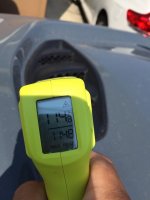 .
.
After temp at hood vent. Note the max temp reading at 122*
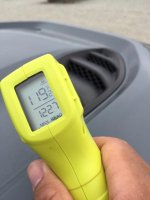 .
.
Before.
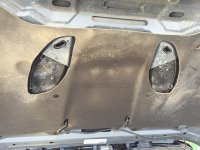 .
.
After.
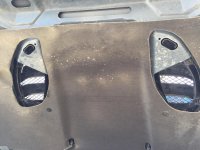 .
.
During.
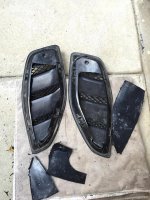 .
.
And if anyone else besides 2nd gunman believed heat didn't rise. Sorry it still rises. And this modification absolutely helps let heat escape.
Before coolant temp via EVIC
 .
. Before temp at hood vent.
 .
. After temp at hood vent. Note the max temp reading at 122*
 .
. Before.
 .
. After.
 .
. During.
 .
.Irish JK
Caught the Bug
Results are in on the quick and dirty 10a vent mod.
And if anyone else besides 2nd gunman believed heat didn't rise. Sorry it still rises. And this modification absolutely helps let heat escape.
Before coolant temp via EVIC
View attachment 217792.
Before temp at hood vent.
View attachment 217793.
After temp at hood vent. Note the max temp reading at 122*
View attachment 217794.
Before.
View attachment 217795.
After.
View attachment 217797.
During.
View attachment 217798.
Nice work!
HighwayTrout
Hooked
Nice work indeed H-T! You went to an awful lot of trouble man! Curious -do you still have the shroud/cover on your engine?
No problem. I've been meaning to do this for a long time.
And no, I haven't had the shroud on for the past few years.
OverlanderJK
Resident Smartass
No problem. I've been meaning to do this for a long time.
And no, I haven't had the shroud on for the past few years.
Where are the heat test results from the blow dryer? Your test is useless without that.


